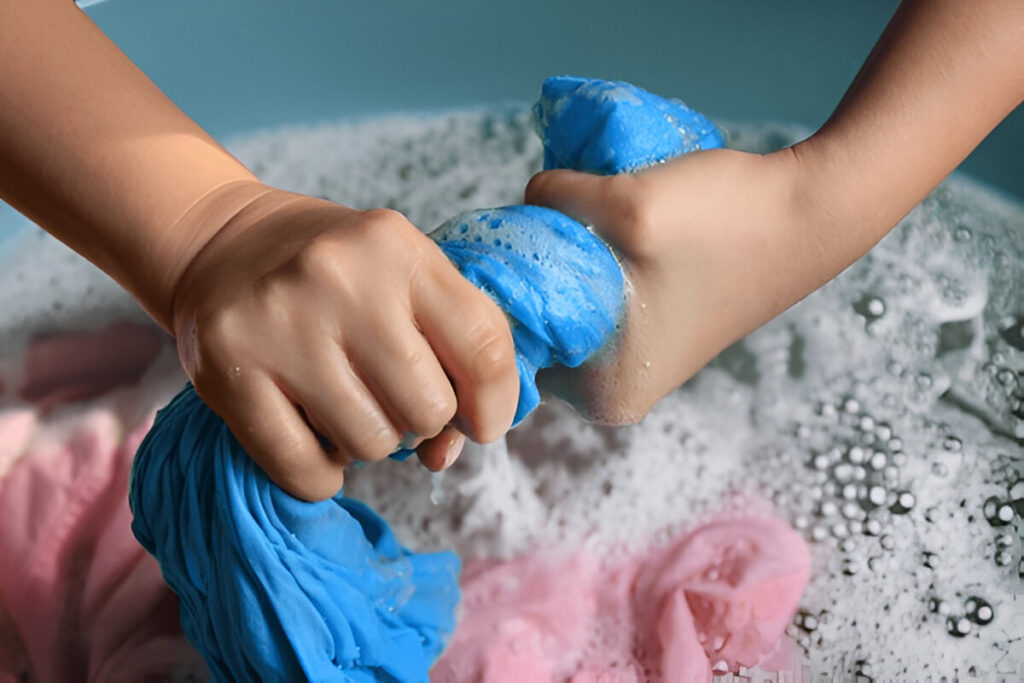In the world of sustainable fashion, we often focus on what we buy: seeking out organic cotton, recycled polyester, and ethical brands. But the single most sustainable act we can practice isn’t found in a store. It’s found in our laundry room.
The truth is, the greenest garment is the one you already own. Every time we extend the life of a piece of clothing by just nine months, we reduce its carbon, water, and waste footprint by a staggering 20-30%.
Caring for your clothes isn’t about being fussy; it’s about being mindful. It’s a radical act of rejecting disposable culture and honoring the resources, labor, and love that went into what you wear. This guide will give you the practical knowledge to become a garment care expert, save money, and build a wardrobe that lasts for years, not seasons.
Step 1: The First Rule of Fight Club – Read the Damn Label!

Before you do anything, check the care label. It’s the manufacturer’s handbook for your garment. Those little symbols might seem like hieroglyphics, but they hold the key to longevity. Here’s a quick cheat sheet:
- Washtub with a number: The maximum wash temperature (e.g., 30°C is cold, 40°C is warm).
- Washtub with a hand: Hand wash only.
- Washtub with an X: Do not wash.
- Circle: Dry clean only (often seen on suits, silk, and structured pieces).
- Square with a circle: Tumble dry allowed.
- Iron with an X: Do not iron.
- Triangle with an X: Do not bleach.
Step 2: The Gentle Art of Washing – Less is More

Overwashing is the number one cause of wear and tear. You often don’t need to wash something after every wear.
- The Sniff Test: Does it actually smell? If not, air it out.
- Spot Clean: Got a small stain? Treat the spot directly instead of washing the entire garment.
- Cold Water is King: Wash almost everything in cold water (30°C or below). It uses less energy, prevents colors from fading, and minimizes shrinkage.
- Turn Clothes Inside Out: This protects the outer surface from friction and fading in the wash.
- Zip It Up and Button It: This prevents snagging and damage to other items and the drum itself.
- Use a Guppyfriend or Cora Ball: These brilliant tools catch microplastic fibers shed from synthetic fabrics (like polyester and nylon) in the wash, preventing them from entering our waterways.
Step 3: The Detergent Dilemma – Choosing Your Potion

Not all detergents are created equal.
- Avoid Harsh Chemicals: Skip optical brighteners and heavy fragrances. They can break down fibers and cause irritation.
- Consider Natural Alternatives: Soap nuts or detergents made for sensitive skin are often gentler on fabrics.
- Less is More: Using too much detergent doesn’t get clothes cleaner; it leaves a residue that traps dirt and odors, forcing you to wash them again sooner.
Step 4: The Drying Debate – Why You Should Ditch the Dryer
The dryer is your wardrobe’s worst enemy. It’s brutal on elastic, shrinks natural fibers, and sets stains.
- Air Dry Whenever Possible: Hang dry your clothes on a line or a drying rack. It’s free and emission-free.
- Lay Flat to Dry (Flat Dry): Essential for heavy knits (sweaters), lingerie, and anything stretchy to prevent them from losing their shape.
- The Right Hangers: Use padded or wooden hangers for blouses and jackets to prevent shoulder bumps.
- Avoid Direct Sunlight: While sunlight is a natural disinfectant, prolonged direct exposure can fade dark and bright colors.
Step 5: The Ironing & Steaming Showdown

- Steamers are Your Friend: A handheld steamer is gentler than an iron. It removes wrinkles without direct contact and is safe for almost all fabrics, including delicate silks and wools.
- Iron with Care: If you must iron, use the correct temperature setting. Iron clothes inside out or use a pressing cloth (a thin white cotton cloth) to prevent scorching and shine on dark fabrics.
Step 6: Master the Mend – A Stitch in Time Saves Nine
A missing button or a small tear doesn’t have to be the end.
- Learn Basic Sewing: Knowing how to sew a button and mend a small seam is an empowering life skill. It’s a direct act of sustainable fashion.
- Visible Mending (Kintsugi for Clothes): Turn a repair into a feature! Use colorful thread or a fun patch to add character and story to your garment.
- Find a Good Tailor: For more complex repairs or alterations (like taking in a waist or hemming pants), a good tailor is worth their weight in gold. They can make old clothes fit like new.
Step 7: The Art of Storage – Out of Season, Not Out of Mind

How you store your clothes matters.
- Clean Before Storing: Never store clothes that are dirty or have unseen stains; they can set and attract pests.
- Breathe: Use cotton storage bags or boxes instead of plastic, which can trap moisture and lead to mildew.
- Cedar Blocks > Mothballs: Natural cedar blocks or rings repel moths without toxic chemicals and smell wonderful.
Your New Laundry Routine: A Quick-Check List
- Before Wash: Sniff test? Spot clean? Check label? Turn inside out? Zip/button?
- The Wash: Cold water. Gentle detergent. Guppyfriend bag for synthetics.
- Before Wear: Steam out wrinkles.
- After Wear: Air out. Spot clean if needed.
- When Damaged: Mend it immediately!
Adopting these habits transforms laundry from a mundane chore into a quiet practice of mindfulness and care. It’s the ultimate way to honor your clothes, your wallet, and the planet. By making your clothes last longer, you’re not just maintaining fabric; you’re curating a story and building a truly sustainable wardrobe from the ground up.






